‘Nimona’ Creator ND Stevenson And Directors Nick Bruno & Troy Quane On An “Unapologetically Pro-LGBTQ+” Story That Refuses To Conform
- Oops!Something went wrong.Please try again later.
- Oops!Something went wrong.Please try again later.

Nimona has had quite a journey before arriving on Netflix. After Disney acquired Blue Sky Studios, the film was repeatedly delayed before being canceled in 2021 when the studio was dissolved. Directors Nick Bruno and Troy Quane, along with the creator of the graphic novel ND Stevenson, liken the experience to the story of Nimona, the “scrappy underdog” fighting against the superpower looking for conformity. The fight paid off the following year, where Annapurna Pictures and Netflix picked up the film and gave it a new chance at life.
Based on Stevenson’s original graphic novel, Nimona takes place in a futuristic medieval world. Ballister (Riz Ahmed), a knight framed for killing the Queen, meets Nimona, a shapeshifting teenager looking to embrace villainy, and the pair sets out to prove Ballister’s innocence. Along the way the pair bond, and the lines between heroes and monsters starts to blur. During development, a large amount of support for the film came from people in the LGBTQ+ community who connected with the graphic novel’s themes, and the trio made sure that they never compromised on bringing that vision to the screen.
More from Deadline
'Letterkenny' Creator Jared Keeso Strikes First-Of-Its-Kind Content Pact With Crave & New Metric
Korean Streaming Subs Reach 19M While Market Braces For Tving, Wavve Merger
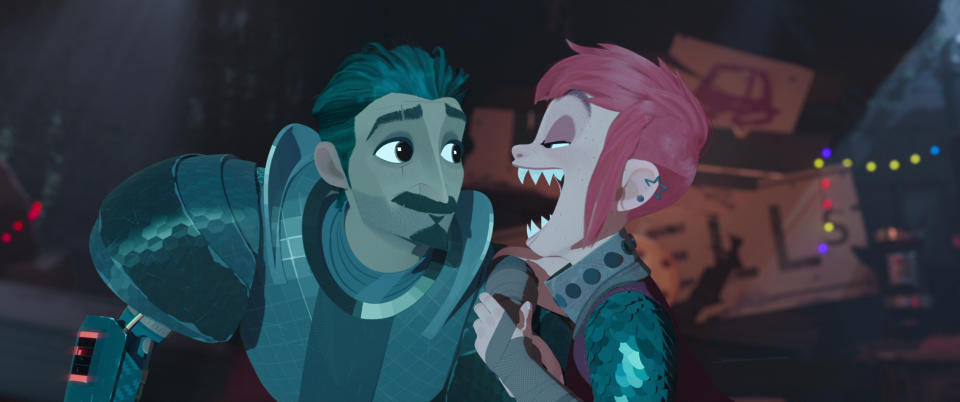
DEADLINE: How did the process of turning the graphic novel into a film begin?
TROY QUANE: Listen, that is a loaded question that we could spend the whole time on, but the simple answer is it was just reading over the material. It was having conversations with a lot of the crew at the studio at Blue Sky, where we started the film, and talking to them about what was connecting to them and the characters that really spoke to them. Then reaching out to Nate and having conversations with him about what these things meant to him and what it was in the material that connected to us. It was really that idea of seeing someone for who they are and for who they want to be. Not just assuming who they are and not accepting them for something you think they should be, but truly seeing someone for who they are. We focused on those characters in that journey to support, and a big part of that was the LGBTQ+ community at the studio. They were such huge fighters for this movie and it was clear that that had to be the focus of how we represented these characters honestly and truthfully.
ND STEVENSON: From my point of view, my thing was just always making sure that it stayed true to Nimona herself. Just making sure that character was right because, from where I was standing, that’s what this story is. If she gets sanded down or if she gets turned into a character who’s cuter, more generic… I don’t know. I really wanted to make sure it felt like her no matter what and so it was really great to end up with this group of minds who saw her and loved her for who she was and once that started clicking everything just started falling into place, but that’s kind of easy for me to say from my side. These guys were the ones who had to do all the hard work. People started seeing themselves in Nimona so much and then Nick and Troy did such an incredible job of making sure that those voices had their platform and were supported and protected in a way that meant a lot to me. I know it did to everyone on the crew.
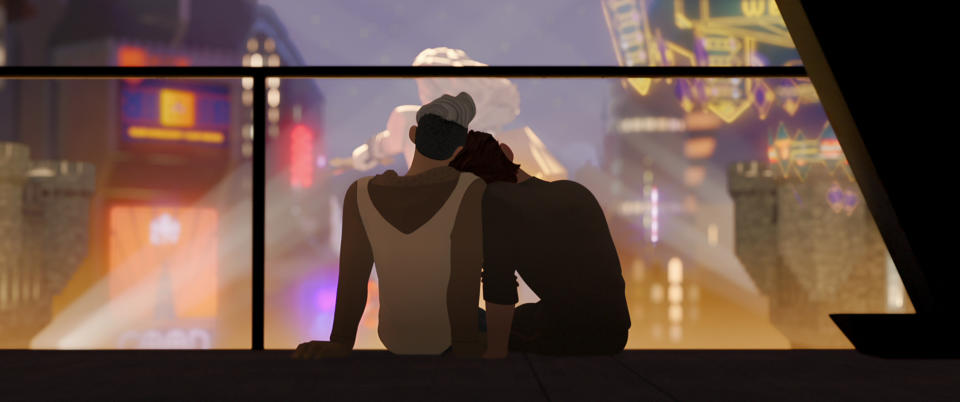
NICK BRUNO: Between the three of us, we knew the story we wanted to tell and it was unapologetically pro-LGBTQ+… and Disney was not. That was very challenging for us, and we knew how many people were connected to the original source material and that’s what made it special. Not just because that’s what it was about, it connected with those members because Nimona is a character who doesn’t conform. Nimona is a character who just wants to be seen for who she is and it’s complex. That’s the story we wanted to tell and not everybody was on board until we found Megan Ellison at Annapurna and Netflix.
Part of what makes this movie stand out is that nobody sets out to tell a story with these themes and messages. We were lucky enough to find what ND did as a young kid. We had something to fight for with the characters in our film and, at the same time, it’s incredibly fun and visually amazing. But when we’re [doing interviews], we’re not talking about how cool it looks. We’re talking about how awesome the connection is with the people that have seen this movie and that’s the greatest reward we can ever get.
STEVENSON: The process of making the movie ended up mirroring the plot of the movie itself in so many ways, this scrappy underdog rising up against this huge superpower that wants to keep it down and make things conform. I think that was what really kept us all going during the hardest parts. It was just love for each other and a refusal to stay down and die, which I think was very Nimona. I feel like she made all of us a little more punk rock.
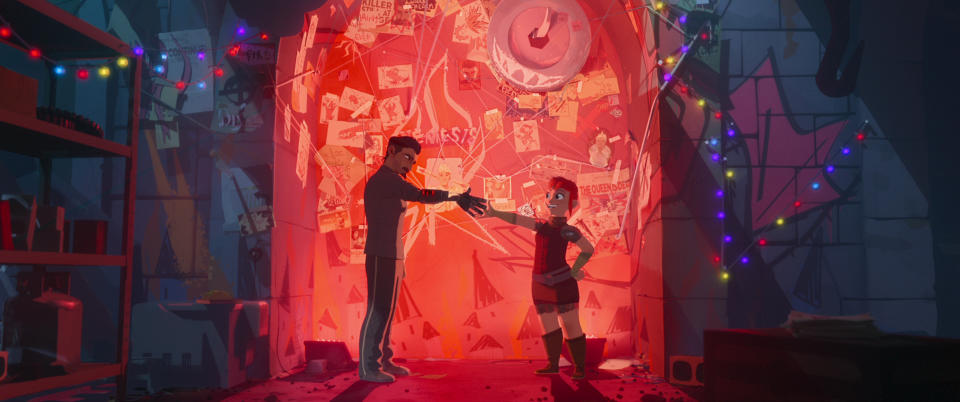
DEADLINE: I love that line, when Ballister asks what she is and she just replies, “I’m Nimona.” It’s very powerful when you’re watching this character refusing to put herself in a box for someone else.
QUANE: That came from all these conversations and we all shared the idea that her answer is always the same, “I’m Nimona.” And it takes Ballister the entire movie to finally hear that. The first time he says her name through the whole movie is at the end because it took him that long. Even though he’s trying, he’s still making mistakes, but it took him to the end.
STEVENSON: I get the question kind of a lot these days about where that name even came from and there’s not really an answer to that. It was just something that sprang into my mind. I think looking back at creating this webcomic, not knowing if anyone was gonna read it, maybe I should have thought up a different name that would get people on board and get people interested in reading instead of this word that no one’s ever heard. But I think that’s what this movie is and you can’t take that away. You can’t change that. You can’t turn it into anything different.
Sometimes it feels like genres are getting narrower and narrower, and you can describe everything in an elevator pitch of, ‘it’s this plus this equals this.’ It can be hard to kind of sum up what Nimona is about in just a couple words, it is its own thing that came out of a desire to see the story that I didn’t see anywhere else. It’s been really cool just seeing how many different people, and how many different kinds of people, all over the world have related to that story and that character. It never stops blowing my mind.
I had no idea that it was gonna have this kind of life back at the beginning when I was a 19-year-old art student making a webcomic. I’ve just seen so many people connect with this character and with this story because they also feel misunderstood and unseen. It’s been really cool to see the ways that this movie doesn’t fit in, or this character doesn’t fit in, but lots of people see themselves in that. I think that’s just another case of the movie as it exists in the world reflecting what the story is about and what the process was making it.
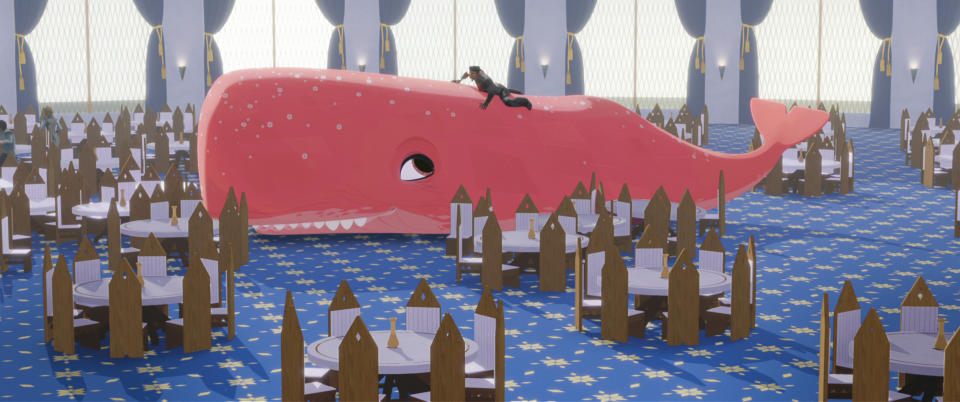
DEADLINE: I feel like animation specifically is kind of the perfect medium to get this message across.
BRUNO: All of us on this zoom have thought about this a lot, because it’s part of the reason why we loved animation. It was one of the few things that would pull a whole family together to watch, and it’s something we’re very aware of when we make any movie. We say, “What’s that family gonna talk about on the ride home from the movie theater, or as they’re packing up the popcorn that’s caught between the cushions of their couch?” For us, that message is to get to know people. It’s just that simple and I think you get it as a kid, you get it as an adult and hopefully you walk away with a better understanding of how to make a better world.
DEADLINE: Chloë Grace Moretz is such a perfect casting for the voice of Nimona. Was the character difficult to cast?
BRUNO: It could have been and it should have been. We wanted whoever we were going to cast to feel what the characters have been feeling in their real life, so that our conversations were meaningful behind the scenes and it wasn’t just, ‘talk louder’ or ‘act like you’re running.’ With everybody that we cast in this film, they definitely have a very unique perspective on how their character’s thinking and what they are going through. With Chloë, it was evident from the beginning in our conversation with her how she felt connected to the character, but I think one of the best things that she brought to it was… Nimona is this character that talks about murder and mayhem and villainy, and there’s definitely some truth to all that, but also that’s a huge cover for somebody who has this giant marshmallow heart who just wants to be loved and seen for who they are. And Chloë has a lot of that, you can feel that in both her humor and when you’re just talking to her. She brought everything to Nimona and I feel like it’s a real standout character.
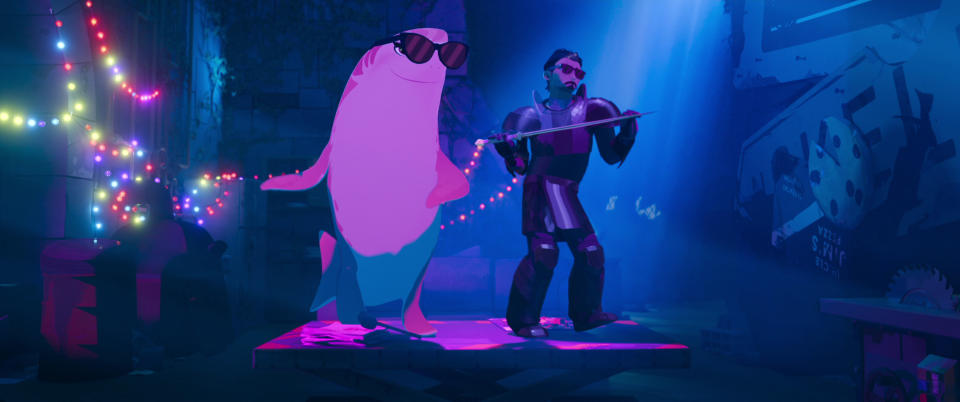
DEADLINE: I know you said you don’t really get to talk about how awesome the film looks, but I want to talk about it because the animation style does look awesome.
QUANE: It really was this idea of marrying the nostalgia of a 2D look with the technology of CG. It’s like that medieval futuristic society that Nate had created that moved forward in time with flying cars and knights with cell phones, but society was still stuck in the past with a bit of a narrow-minded view of how to look forward. So, I just felt like there was this fun opportunity to mirror those thematic elements in how we were executing the look of the film. I hope it stands out a little bit more than something that would just be striking to the eye, and that it resonates with those ideas. I mean, we do things like the further things get away from camera, we don’t just blur them out for distance. We actually start removing detail, do more simplified geometry. And that was just this idea of being closer. We let people get to us the more we see the details that make up their unique selves, but the further we hold people away the more they become generic and sort of detail-less and we’re allowed to put our own thoughts and ideas and impressions on them. We’re just always looking to make sure that the style represents the story we’re trying to tell and this great material that Nate gave us to work with.
STEVENSON: The comic was made digitally, but I was always trying to look for how to make it feel handmade. So, there’s a lot of paper texture and using liners that had that kind of tooth, that scratchiness to them the way that a pencil would. As technology evolves, you don’t necessarily have to do that, but it made me feel more connected to the story to feel like I was my own kind of medieval scribe creating. So, it was really cool to see that reflection in the movie, even the paper texture and the way that there’s a texture and a glow to everything that is very high tech and yet it’s also very bold, very graphic, like the way that the beveled armor catches the light. The animators spent an incredible amount of time designing every single shot to be graphic and to get that idea across of the dark and the light and how it’s not what you expect. I was so completely blown away and just overjoyed by the attention to detail. It’s really different from the comic in lots of ways, and yet it feels like it’s an evolution of a lot of the same ideas.
Best of Deadline
2023 Premiere Dates For New & Returning Series On Broadcast, Cable & Streaming
2023-24 Awards Season Calendar - Dates For Oscars, Emmys, Grammys, Tonys, Guilds & More
Colman Domingo To Receive Palm Springs Film Festival's Spotlight Award, Actor
Sign up for Deadline's Newsletter. For the latest news, follow us on Facebook, Twitter, and Instagram.

